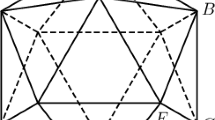Abstract
A simple matrix is a (0,1)-matrix with no repeated columns. For a (0,1)-matrix F, we say that a (0,1)-matrix A has F as a configuration if there is a submatrix of A which is a row and column permutation of F (trace is the set system version of a configuration). Let \({\|A\|}\) denote the number of columns of A. We define \({{\rm forb}(m, F) = {\rm max}\{\|A\| \,:\, A}\) is m-rowed simple matrix and has no configuration F. We extend this to a family \({\mathcal{F} = \{F_1, F_2, \ldots , F_t\}}\) and define \({{\rm forb}(m, \mathcal{F}) = {\rm max}\{\|A\| \,:\, A}\) is m-rowed simple matrix and has no configuration \({F \in \mathcal{F}\}}\) . We consider products of matrices. Given an m 1 × n 1 matrix A and an m 2 × n 2 matrix B, we define the product A × B as the (m 1 + m 2) × n 1 n 2 matrix whose columns consist of all possible combinations obtained from placing a column of A on top of a column of B. Let I k denote the k × k identity matrix, let \({I_k^{c}}\) denote the (0,1)-complement of I k and let T k denote the k × k upper triangular (0,1)-matrix with a 1 in position i, j if and only if i ≤ j. We show forb(m, {I 2 × I 2, T 2 × T 2}) is \({\Theta(m^{3/2})}\) while obtaining a linear bound when forbidding all 2-fold products of all 2 × 2 (0,1)-simple matrices. For two matrices F, P, where P is m-rowed, let \({f(F, P) = {\rm max}_{A} \{\|A\| \,:\,A}\) is m-rowed submatrix of P with no configuration F}. We establish f(I 2 × I 2, I m/2 × I m/2) is \({\Theta(m^{3/2})}\) whereas f(I 2 × T 2, I m/2 × T m/2) and f(T 2 × T 2, T m/2 × T m/2) are both \({\Theta(m)}\). Additional results are obtained. One of the results requires extensive use of a computer program. We use the results on patterns due to Marcus and Tardos and generalizations due to Klazar and Marcus, Balogh, Bollobás and Morris.
Similar content being viewed by others
References
Anstee, R.P.: A survey of forbidden configurations results. Elec. J. Comb. 20, DS20 (2013)
Anstee R.P., Fleming B.: Two refinements of the bound of Sauer, Perles and Shelah and Vapnik and Chervonenkis. Discrete Math. 310, 3318–3323 (2010)
Anstee, R.P., Griggs, J.R., Sali, A. Small forbidden configurations. Graphs Comb. 13, 97–118 (1997)
Anstee R.P., Sali A.: Small forbidden configurations IV. Combinatorica 25, 503–518 (2005)
Anstee, R.P., Fleming, B., Füredi, Z., Sali, A.: Color critical hypergraphs and forbidden configurations, proceedings of EuroComb 2005, Berlin, Germany. Discrete Math. Theor. Comput. Sci. AE, 117–122 (2005)
Balogh J., Bollobás B.: Unavoidable traces of set systems. Combinatorica 25, 633–643 (2005)
Balogh J., Bollobás B., Morris R.: Hereditary properties of partitions, ordered graphs and ordered hypergraphs. Eur. J. Comb. 8, 1263–1281 (2006)
Erdős P.: On extremal problems of graphs and generalized graphs. Israel J. Math. 2, 183–190 (1964)
Erdős P., Simonovits M.: A limit theorem in graph theory. Studia Sci. Math. Hung. 1, 51–57 (1966)
Erdős P., Stone A.H.: On the structure of linear graphs. Bull. AMS 52, 1089–1091 (1946)
Füredi Z.: An upper bound on Zarankiewicz problem. Comb. Probab. Comput. 5, 29–33 (1996)
Füredi Z., Hajnal P.: Davenport–Schinzel theory of matrices. Discrete Math. 103, 233–251 (1992)
Klazar M., Marcus A.: Extensions of the linear bound in the Füredi–Hajnal conjecture. Adv. Appl. Math. 38, 258–266 (2007)
Kővari, T., Sós, V., Turán, P.: On a problem of K. Zarankiewicz. Colloq. Math 3(1954), 50–57.
Marcus A., Tardos G.: Excluded permutation matrices and the Stanley Wilf conjecture. J. Combin. Theory Ser. A 107, 153–160 (2004)
Raggi, M.: Computer code. http://www.math.ubc.ca/~anstee/FCConfThesisVersion.tar.gz
Tardos G.: On 0–1 matrices and small excludedsubmatrices. J. Combin. Theory Ser. A 111, 266–288
Author information
Authors and Affiliations
Corresponding author
Additional information
Richard P. Anstee, Research supported in part by NSERC and Hungarian National Research Fund (OTKA) Grant no. NK 78439, Christina Koch, Research supported in part by NSERC of first author, Miguel Raggi, Research supported in part by NSERC of first author, Attila Sali, Research was supported in part by Hungarian National Research Fund (OTKA) Grant No. NK 78439.
Rights and permissions
About this article
Cite this article
Anstee, R.P., Koch, C., Raggi, M. et al. Forbidden Configurations and Product Constructions. Graphs and Combinatorics 30, 1325–1349 (2014). https://doi.org/10.1007/s00373-013-1365-1
Received:
Revised:
Published:
Issue Date:
DOI: https://doi.org/10.1007/s00373-013-1365-1




